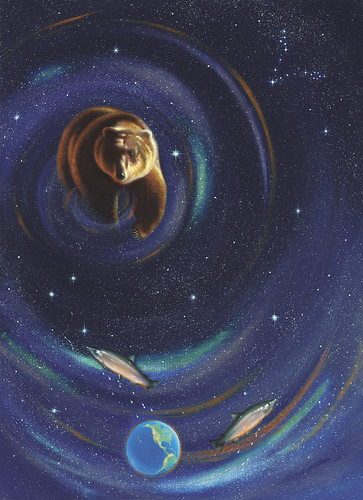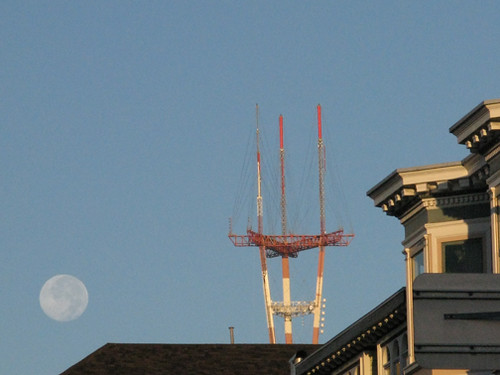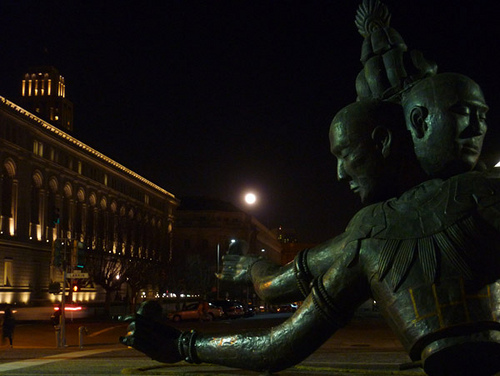The emails came in immediately. “What, I’m no longer a Sadge?,” one friend inquired. My facebook wall lit up with cries for help ranging from the slightly perplexed “what’s up with the new zodiac sign dates” to the borderline despairing “Sven, can you help make sense of this new zodiac calendar? I’m hearing so many different things about how it may only apply to people born after a certain year, etc., I’m confused.” As I hunkered down in front of my computer after a nice afternoon on planet Earth, it hit me like a brick: the world as we know it had come to an end.
Rattled by the sudden onset Sun-sign identity crisis all around me, curious where I may have gone wrong in my astrology practice, and quite frankly, not completely unconcerned about digital pitchforks coming at me for the perceived selling of snake oil, I followed the links to the source of the ruckus. Lo and behold, the entire internet was abuzz about an obscure Minnesota astronomer incredibly named Parke Kunkle who had made the rather pedestrian observation that the earth’s equatorial alignment had changed from 2000 years ago when Ptolemy set up the principles of western horoscopic astrology. To add confusion to the chaos, Kunkle had also observed that there’s a thirteenth constellation named Ophiuchus on the ecliptic.
All I could think was “No shit, Sherlock!” Isn’t this what astrologers have known and discussed since people started looking up at the sky? Isn’t the entire field of sidereal, sky-centered astrology based around the orientation of the Earth relative to the galaxy, while western Ptolemaic astrology is fixed to the equinoxes? And isn’t Ophiuchus often used by sidereal astrologers as the thirteenth constellation while tropical astrology is tied to the four seasons and thus functions optimally with the sky sliced into twelve equal parts? Did Mr. Kunkle just discover — and the news media go viral over — what Hindu astrologers have been practicing for centuries?
To make sure I hadn’t completely lost my mind I went to my teacher and friend Steven Forrest’s facebook page to see what he had to say. Bestselling author of The Inner Sky, one of the most widely read introductions to astrology, Steve’s knowledge on the subject runs deep and he’s also one of those cats who understands and has a knack for explaining the physics behind the poetry in layman’s terms. Like concerned reporters lining up for the press conference of a politician embroiled in a corruption scandal, folks were already posting on his wall, wanting to know what he had to say about all this.
Then came the statement:
“Forget about Ophiuchus! Western astrology is hooked to the equinoxes and solstices, not to the constellations. In 1929 the International Astronomical Union formalized the constellation boundaries and decided to include Ophiuchus. This has absolutely zip to do with your birth sign! It is basically a cheap shot at astrology.”
Just as I had thought. In what must have been a black hole in the news cycle, major outlets like Fox News and the Huffington Post had made a benign local story into major headline news and reported like it was 99 AD. As if on cue, all the internet armchair scientists popped up on the comment boards to rejoice in another round of perennial astrology debunking, basking in their perceived absolute empirical knowledge of the universe and delighting in our collective identity crisis. I thought the whole hoopla was actually kind of funny, and my initial instinct was to defuse the anxiety amongst my friends with some lighthearted “oh no, dude, are you one of those poor Ophiuchi now? I’m really sorry because Ophiuchi have a natural tendency to be withdrawn when they’re outgoing, and they gravitate strongly towards ordering meals at restaurants that have been sitting in the freezer the longest.”
Humor is the cosmic lubricant on the great chute to heaven.
All joking aside, this rift between astronomy and astrology is so 18th Century. I mean, I understand and appreciate the contributions of the Enlightenment to the evolution of humankind and why the Age of Reason was a much needed response to the abuses of superstition by The Powers that Were in the Middle Ages. But haven’t we gained a lot more insight into the vast interconnectedness between our physical existence and human consciousness since then? From the dawn of the field of Psychology to Carl Gustav Jung’s study of dreams and archetypes, haven’t we as a modern society embraced the idea of including the less linear and tangible elements of our human existence in our pursuits of knowledge? Isn’t our biggest modern day hero a physicist named Albert Einstein who is most famous for saying things like “The true sign of intelligence is not knowledge but imagination?”
To be fair, many of us astrologers have contributed to the schism. Feeling marginalized by the church of rational thought, we’ve tied ourselves into knots trying to come up with systems that would hold up to the strict and limited standards of scientific proof. In fact, we western astrologers hardly need Mr. Kunkle to gleefully tell us how deluded we are — sidereal astrologers have been taking care of that for ages.
But since Mr. Kunkle has now officially become a sidereal astrologer, he may find himself being held to the same rigorous scientific standards applied by his former astronomy colleagues: “So tell us, Parke, how did you come up with the delineations for these constellations? Where does one end and the next one begin? Isn’t connecting a bunch of random stars in the sky and giving them names and boundaries completely subjective? What if I see different connections? — after all, it’s a big sky with lots of empty space between the little twinkles.

Ursa Major, by Evelyn Terranova
Even when we seem to universally agree on which stars belong together, we look at them through our own personal and cultural lenses. Germans call the Big Dipper the Big Wagon, because that’s what my ancestors saw when they looked up in the sky. To Iroquois Indians, Ursa Major represents a bear (the four stars in the cup ) chased by three Indians (the three stars in in the handle). The Japanese don’t see a man in the moon but a rabbit pounding rice cake. And speaking of celestial objects, isn’t the naming of individual stars and planets also a complete figment of the human imagination? And how can astronomers plead objectivity when they name a planet after a Roman god of the underworld and then vote to demote it as a planet? That certainly doesn’t seem like a universally observable or provable fact, but a judgment call by an organization steeped in politics and personal disagreements, just like the rest of us mere mortals. You know, human, irrational and biased, and beautifully so.
To me, astronomy is the physics, and astrology the poetry of the sky. They both have their strengths and limitations, but why they shouldn’t be able to support each other and enrich our entire human experience is, quite frankly, beyond me. Excuse the pun, but it’s like a match made in heaven: Astronomy provides the deep insight into the complex mechanisms of our solar system, and astrology relates it to our human experience on earth. Astronomy builds the canvas and astrology paints the picture. Astronomy tunes the instrument and astrology plays the song. Astronomy runs the presses and astrology writes the story.
Naturally it would seem that the deeper you delve into one, the more curious you’d become about the other. Ptolemy, Plato and Johannes Kepler became more interested in the mystical elements of the universe as they learned and understood more about its measurable aspects. Likewise, many astrologers I know have developed a deep appreciation for the scientific calculations behind the birth chart and are making the effort to learn more about the complex physical mechanisms that are nowadays easily computer-generated and instantly translated onto a piece of paper. Astrologers may be from Venus and astronomers from Mars, but we share the same passion for shedding a little light on the great mystery of our human existence.
Speaking of mystery, I know you must be itching to find out if you’re still a Sagittarius or need to read up on some Ophiuchus mythology. Well, it all depends on whether you want to remain a Sagittarius or Cancer or Taurus forever and stay firmly rooted in the earth’s seasons or switch your sun sign every couple of thousand years. As one of the commenters on Steve’s facebook wall put it:
“In the end, a moment in time in the sky, the snapshot, remains the same. The zodiac constructs, the house systems, etc., are simply different views of the same moment. Think of an object being photographed. The photographer uses lenses, filters, lighting and angles to create different views, and each view provides a new way of seeing.”

Moon over San Francisco - Man or Rabbit?
So, it depends on whether you prefer to have your cosmic portrait taken straight up and full frontal, in which case you may want to consult a sidereal astrologer (or Parke Kunkle) about Ophiuchus, or from a bit of an angle, in which case you can just relax and go about your Sagittarian business of exploring new perspectives on life. Also, remember that our Sun Signs aren’t the only archetypes through which we experience the world. We all have the Moon, Mercury, Venus, Mars and the outer planets located somewhere in our birth chart, which makes us much more nuanced and three dimensional than we often take credit for. Chances are that one of these other planets falls into the sidereal sign of your Sun. For example, my Sun is in Libra and my Venus in Virgo, so while I’m at home with the archetypes of The Artist and The Peacemaker I also relate well to the imagery of The Servant or The Craftsman.
Ultimately, I would hope that the sudden astronomy and astrology lessons we’re getting will lead to a better understanding of both, and perhaps, a healing of the rift. Instead of the usual knee jerk mocking of astrology as nothing but medieval superstition, why not marvel at the sky together, honoring both what we see and what we feel. Just as the sun and the moon are two very different yet indispensable parts of our physical existence, there’s no contradiction in sharpening our intellect while also opening our heart. After all, we’re humans, not robots, and whether we split up the sky into twelve or thirteen slices, the meaning we derive will always be colored by everyone’s own sacred relationship with the heavens. As Joseph Campbell used to say, “Follow your bliss and the universe will open doors where there were only walls.” Astrology points us to the doors, but it’s up to us which ones we choose to open.








Oh, the questions from your friends are so funny! I was almost among them with, “I’m an Aries now?!” (That does kind of seem like an Aries response now that I think about it.) 🙂
Then I figured if you and Steve stuck with the twelve divisions, I would, too. What a great response to the questions, Sven. You explained how the systems work well enough that most people can understand and you managed to sneak in the potential relationship of science and poetry. Beautiful!
Thanks Pam, I’m a little late to the whole “nontroversy” but it was still fun getting my 2 cents in. : )
“Forget about Ophiuchus! Western astrology is hooked to the equinoxes and solstices, not to the constellations.” That is absolutely correct. The signs of the zodiac have nothing to do with the constellations they are named after (and two of them do not even have the same name as the constellations); they are simply names for an angular measurement system. Instead of using 360 degrees, they use 12 signs. The 0 mark for the tropical zodiac is the vernal equinox, and that is named Aries. So, Aries is 0 degrees, Cancer is 90 degrees, Libra is 180 degrees, and Capricorn is 270 degrees. That is why the tropics are named as such; they are of the signs (angles); not of constellations (if they were constellations, it would be “Capricornus”, not “Capricorn”).
I also do not believe in astrology; however, it is a common mistake to believe that astrology is wrong due to the signs not lining up with the constellations. Astrology *does* get the position of the Sun correct; if it is 0-30 degrees past the vernal equinox then they call that “Aries”. Now, what they do with this information is a completely different matter altogether.
“Well, it all depends on whether you want to remain a Sagittarius or Cancer or Taurus forever and stay firmly rooted in the earth’s seasons or switch your sun sign every couple of thousand years.” Actually, no matter whether you use the tropical or sidereal zodiac, your Sun sign won’t change over time; it is based on where the Sun is at the date of your birth. For example, using the tropical zodiac, March 20, 2008 at UTC 12:00 is Aries, but March 20, 2007 is Pisces because the vernal equinox has not yet occured. If you use the actual IAU boundaries of the constellations, then the only way your Sun sign would change is if the definition of the boundaries of the constellations changes (like how Pluto is not considered a planet, and never was, because the definition of a planet has changed).
“In the end, a moment in time in the sky, the snapshot, remains the same. The zodiac constructs, the house systems, etc., are simply different views of the same moment. Think of an object being photographed. The photographer uses lenses, filters, lighting and angles to create different views, and each view provides a new way of seeing.” This is absolutely correct. When you switch between the tropical or sidereal zodiac, the position of the Sun doesn’t change; it is the zodiac (specifically, the zero point) which changes. Campanus houses project the prime vertical onto the eclpitic, while Regiomontanus houses project the equator onto the ecliptic.
“And speaking of celestial objects, isn’t the naming of individual stars and planets also a complete figment of the human imagination?” Yes, of course it is. But you have to name it something, so that you know what you are refering to!
“Astronomy provides the deep insight into the complex mechanisms of our solar system, and astrology relates it to our human experience on earth. Astronomy builds the canvas and astrology paints the picture. Astronomy tunes the instrument and astrology plays the song. Astronomy runs the presses and astrology writes the story.” From an artistic point of view (that is, astrology being art, like a painting or a piece of music or whatever), this, and everything in this article, is absolutely correct; this is how you do art! So, I suppose you could say, astrology is like how you make paintings and stuff out of the positions of the planets and so on.
“For example, my Sun is in Libra and my Venus in Virgo, so while I’m at home with the archetypes of The Artist and The Peacemaker I also relate well to the imagery of The Servant or The Craftsman.” Well, the archetypes that most people use for the signs are in general such that many people can relate to them. If you read the horoscope interpretations in the newspaper, you tend to see your personalities from the point of view of your Sun sign, but you can really do it in whatever way you like to do so (after all, it is art, and art can be done in whatever way you like (for example, classical music is different from jazz music, and watercolor is different from pencil drawings)). Of course there are cases where you might not like it or not relate to it; but that is OK.
However, there are things you can objectively deduce from a horoscope. If you know that your Sun sign is Aries and Moon sign is Libra, it is probably a full moon. Conversely, if you know your Sun sign is Aries and that it is a full moon, you could deduce your Moon sign to be Libra. But if your Sun sign is in Aries, then your Venus sign could not possibly be Libra, because that would mean the Venus is on the opposite side of the Earth from the Sun, which would mean that Venus orbits the Sun farther away than the Earth does, which is wrong.
(P.S. I am the same “Anonymous” guy as above; but I forgot to write some things so now I did so)
Thanks for your comments, anonymous, I appreciate you taking the time to explain some of the things I missed, and to do it in such a respectful way even though astrology is not your thing.
I was always aware that the moon opposite the sun is full. It makes a lot of sense even from a real life perspective, as you can see the full moon rising while the sun is setting on the other side. However, very interesting point about Venus never being opposite the sun. I had never thought of it, but indeed, after going through a bunch of charts I could not detect a single one where Venus was opposite the Sun. In fact, it seems that Venus hardly ever strays more than 60 degrees away from the sun. And then of course the same holds true for Mercury, it seems like the orbs are even tighter. I can’t believe I’ve never noticed that, so thanks for that lesson.
As far as the archetypes, I do think you have a point that people tend to find ways to identify with the popular characteristics of their Sun signs, creating a kind of a chicken/egg effect. Where it steps out of that realm for me though is when I do someone’s chart and integrate all the other planets into a much more 3-dimensional reading. Almost nobody knows what sign their natal Venus or Uranus is in, so once they’re taken out of the cookie cutter identification with a handful of stereotypes, the experience gets much deeper, more meaningful, and I believe accurate. I still think it’s an art form and never claim otherwise, as I wrote in the essay, I don’t see a point in getting into arguments with scientists, but it’s quite amazing how well it works and how deeply it takes people into their “soul truth” and ultimately helps them to live more conscious and authentic lives.